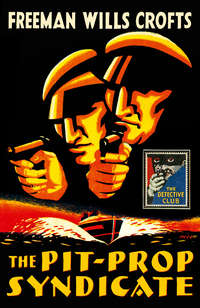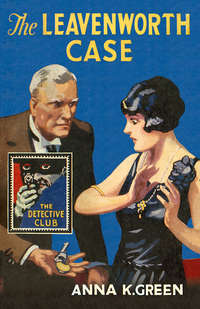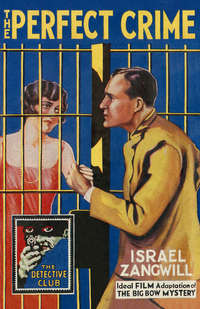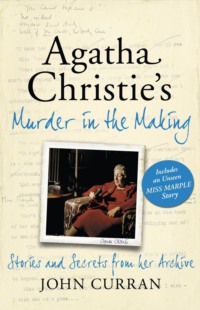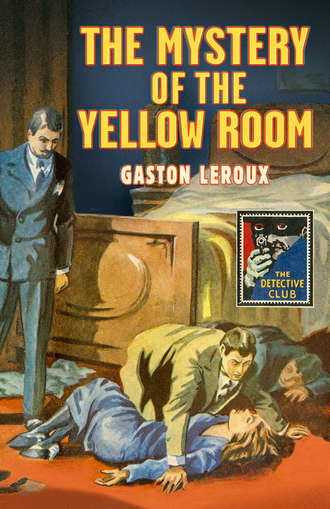
Полная версия
The Mystery of the Yellow Room
‘The work of the dramatic author may interfere,’ he said, after a slight hesitation, ‘with that of the magistrate, especially in a province where one’s labours are little more than routine.’
‘Oh, you may rely on my discretion!’ cried Rouletabille.
The train was in motion.
‘We have started!’ said the examining magistrate, surprised at seeing us still in the carriage.
‘Yes, Monsieur—truth has started,’ said Rouletabile, smiling amiably—‘on its way to the Château du Glandier. A fine case, Monsieur de Marquet—a fine case!’
‘An obscure—incredible, unfathomable, inexplicable affair—and there is only one thing I fear, Monsieur Rouletabille—that the journalists will be trying to explain it.’
My friend felt this a rap on his knuckles.
‘Yes,’ he said simply, ‘that is to be feared. They meddle in everything. As for my interest, monsieur, I only referred to it by mere chance—the mere chance of finding myself in the same train with you, and in the same compartment of the same carriage.’
‘Where are you going, then?’ asked Monsieur de Marquet.
‘To the Château du Glandier,’ replied Rouletabille, without turning.
‘You’ll not get in, Monsieur Rouletabille!’
‘Will you prevent me?’ said my friend, already prepared to fight.
‘Not I! I like the press and journalists too well to be in any way disagreeable to them; but Monsieur Stangerson has given orders for his door to be closed against everybody, and it is well guarded. Not a journalist was able to pass through the gate of the Glandier yesterday.’
Monsieur de Marquet compressed his lips and seemed ready to relapse into obstinate silence. He only relaxed a little when Rouletabille no longer left him in ignorance of the fact that we were going to the Glandier for the purpose of shaking hands with an ‘old and intimate friend,’ Monsieur Robert Darzac—a man whom Rouletabille had perhaps seen once in his life.
‘Poor Robert!’ continued the young reporter, ‘this dreadful affair may be his death—he is so deeply in love with Mademoiselle Stangerson.’
‘His sufferings are truly painful to witness,’ escaped like a regret from the lips of Monsieur de Marquet.
‘But it is to be hoped that Mademoiselle Stangerson’s life will be saved.’
‘Let us hope so. Her father told me yesterday that, if she does not recover, it will not be long before he joins her in the grave. What an incalculable loss to science his death would be!’
‘The wound on her temple is serious, is it not?’
‘Evidently; but, by a wonderful chance, it has not proved mortal. The blow was given with great force.’
‘Then it was not with the revolver she was wounded,’ said Rouletabille, glancing at me in triumph.
Monsieur de Marquet appeared greatly embarrassed.
‘I didn’t say anything—I don’t want to say anything—I will not say anything,’ he said. And he turned towards his Registrar as if he no longer knew us.
But Rouletabille was not to be so easily shaken off. He moved nearer to the examining magistrate and, drawing a copy of the Matin from his pocket, he showed it to him and said:
‘There is one thing, Monsieur, which I may enquire of you without committing an indiscretion. You have, of course, seen the account given in the Matin? It is absurd, is it not?’
‘Not in the slightest, Monsieur.’
‘What! The Yellow Room has but one barred window—the bars of which have not been moved—and only one door, which had to be broken open—and the assassin was not found!’
‘That’s so, monsieur—that’s so. That’s how the matter stands.’
Rouletabille said no more but plunged into thought. A quarter of an hour thus passed.
Coming back to himself again he said, addressing the magistrate:
‘How did Mademoiselle Stangerson wear her hair on that evening?’
‘I don’t know,’ replied Monsieur de Marquet.
‘That’s a very important point,’ said Rouletabille. ‘Her hair was done up in bands, wasn’t it? I feel sure that on that evening, the evening of the crime, she had her hair arranged in bands.’
‘Then you are mistaken, Monsieur Rouletabille,’ replied the magistrate; ‘Mademoiselle Stangerson that evening had her hair drawn up in a knot on the top of her head—her usual way of arranging it—her forehead completely uncovered. I can assure you, for we have carefully examined the wound. There was no blood on the hair, and the arrangement of it has not been disturbed since the crime was committed.’
‘You are sure! You are sure that, on the night of the crime, she had not her hair in bands?’
‘Quite sure,’ the magistrate continued, smiling, ‘because I remember the Doctor saying to me, while he was examining the wound, ‘It is a great pity Mademoiselle Stangerson was in the habit of drawing her hair back from her forehead. If she had worn it in bands, the blow she received on the temple would have been weakened.’ It seems strange to me that you should attach so much importance to this point.’
‘Oh! If she had not her hair in bands, I give it up,’ said Rouletabille, with a despairing gesture.
‘And was the wound on her temple a bad one?’ he asked presently.
‘Terrible.’
‘With what weapon was it made?’
‘That is a secret of the investigation.’
‘Have you found the weapon—whatever it was?’
The magistrate did not answer.
‘And the wound in the throat?’
Here the examining magistrate readily confirmed the decision of the doctor that, if the murderer had pressed her throat a few seconds longer, Mademoiselle Stangerson would have died of strangulation.
‘The affair as reported in the Matin,’ said Rouletabille eagerly, ‘seems to me more and more inexplicable. Can you tell me, Monsieur, how many openings there are in the pavilion? I mean doors and windows.’
‘There are five,’ replied Monsieur de Marquet, after having coughed once or twice, but no longer resisting the desire he felt to talk of the whole of the incredible mystery of the affair he was investigating. ‘There are five, of which the door of the vestibule is the only entrance to the pavilion—a door always automatically closed, which cannot be opened, either from the outer or inside, except with the two special keys which are never out of the possession of either Daddy Jacques or Monsieur Stangerson. Mademoiselle Stangerson had no need for one, since Daddy Jacques lodged in the pavilion and because, during the daytime, she never left her father. When they, all four, rushed into the Yellow Room, after breaking open the door of the laboratory, the door in the vestibule remained closed as usual and, of the two keys for opening it, Daddy Jacques had one in his pocket, and Monsieur Stangerson the other. As to the windows of the pavilion, there are four; the one window of the Yellow Room and those of the laboratory looking out on to the country; the window in the vestibule looking into the park.’
‘It is by that window that he escaped from the pavilion!’ cried Rouletabille.
‘How do you know that?’ demanded Monsieur de Marquet, fixing a strange look on my young friend.
‘We’ll see later how he got away from the Yellow Room,’ replied Rouletabille, ‘but he must have left the pavilion by the vestibule window.’
‘Once more—how do you know that?’
‘How? Oh, the thing is simple enough! As soon as he found he could not escape by the door of the pavilion his only way out was by the window in the vestibule, unless he could pass through a grated window. The window of the Yellow Room is secured by iron bars, because it looks out upon the open country; the two windows of the laboratory have to be protected in like manner for the same reason. As the murderer got away, I conceive that he found a window that was not barred—that of the vestibule, which opens on to the park—that is to say, into the interior of the estate. There’s not much magic in all that.’
‘Yes,’ said Monsieur de Marquet, ‘but what you have not guessed is that this single window in the vestibule, though it has no iron bars, has solid iron blinds. Now these iron blinds have remained fastened by their iron latch; and yet we have proof that the murderer made his escape from the pavilion by that window! Traces of blood on the inside wall and on the blinds as well as on the floor, and footmarks, of which I have taken the measurements, attest the fact that the murderer made his escape that way. But then, how did he do it, seeing that the blinds remained fastened on the inside? He passed through them like a shadow. But what is more bewildering than all is that it is impossible to form any idea as to how the murderer got out of the Yellow Room, or how he got across the laboratory to reach the vestibule! Ah, yes, Monsieur Rouletabille, it is altogether as you said, a fine case, the key to which will not be discovered for a long time, I hope.’
‘You hope, Monsieur?’
Monsieur de Marquet corrected himself.
‘I do not hope so—I think so.’
‘Could that window have been closed and refastened after the flight of the assassin?’ asked Rouletabille.
‘That is what occurred to me for a moment; but it would imply an accomplice or accomplices—and I don’t see—’
After a short silence he added:
‘Ah—if Mademoiselle Stangerson were only well enough today to be questioned!’
Rouletabille following up his thought, asked:
‘And the attic? There must be some opening to that?’
‘Yes; there is a window, or rather skylight, in it, which, as it looks out towards the country, Monsieur Stangerson has had barred, like the rest of the windows. These bars, as in the other windows, have remained intact, and the blinds, which naturally open inwards, have not been unfastened. For the rest, we have not discovered anything to lead us to suspect that the murderer had passed through the attic.’
‘It seems clear to you, then, Monsieur, that the murderer escaped—nobody knows how—by the window in the vestibule?’
‘Everything goes to prove it.’
‘I think so, too,’ confessed Rouletabille gravely.
After a brief silence, he continued:
‘If you have not found any traces of the murderer in the attic, such as the dirty footmarks similar to those on the floor of the Yellow Room, you must come to the conclusion that it was not he who stole Daddy Jacques’s revolver.’
‘There are no footmarks in the attic other than those of Daddy Jacques himself,’ said the magistrate with a significant turn of his head. Then, after an apparent decision, he added: ‘Daddy Jacques was with Monsieur Stangerson in the laboratory—and it was lucky for him he was.’
‘Then what part did his revolver play in the tragedy? It seems very clear that this weapon did less harm to Mademoiselle Stangerson than it did to the murderer.’
The magistrate made no reply to this question, which doubtless embarrassed him. ‘Monsieur Stangerson,’ he said, ‘tells us that the two bullets have been found in the Yellow Room, one embedded in the wall stained with the impression of a red hand—a man’s large hand—and the other in the ceiling.’
‘Oh! Oh! In the ceiling!’ muttered Rouletabille. ‘In the ceiling! That’s very curious! In the ceiling!’
He puffed awhile in silence at his pipe, enveloping himself in the smoke. When we reached Savigny-sur-Orge, I had to tap him on the shoulder to arouse him from his dream and come out on to the platform of the station.
There, the magistrate and his Registrar bowed to us, and by rapidly getting into a cab that was awaiting them, made us understand that they had seen enough of us.
‘How long will it take to walk to the Château du Glandier?’ Rouletabille asked one of the railway porters.
‘An hour and a half or an hour and three quarters—easy walking,’ the man replied.
Rouletabille looked up at the sky and, no doubt, finding its appearance satisfactory, took my arm and said:
‘Come on! I need a walk.’
‘Are things getting less entangled?’ I asked.
‘Not a bit of it!’ he said, ‘more entangled than ever! It’s true, I have an idea—’
‘What’s that?’ I asked.
‘I can’t tell you what it is just at present—it’s an idea involving the life or death of two persons at least.’
‘Do you think there were accomplices?’
‘I don’t think it—’
We fell into silence. Presently he went on:
‘It was a bit of luck, our falling in with that examining magistrate and his Registrar, eh? What did I tell you about that revolver?’ His head was bent down, he had his hands in his pockets, and he was whistling. After a while I heard him murmur:
‘Poor woman!’
‘Is it Mademoiselle Stangerson you are pitying?’
‘Yes; she’s a noble woman and worthy of being pitied! A woman of a great, a very great character—I imagine—I imagine.’
‘You know her then?’
‘Not at all. I have never seen her.’
‘Why, then, do you say that she is a woman of great character?’
‘Because she bravely faced the murderer; because she courageously defended herself—and, above all, because of the bullet in the ceiling.’
I looked at Rouletabille and inwardly wondered whether he was not mocking me, or whether he had not suddenly gone out of his senses. But I saw that he had never been less inclined to laugh, and the brightness of his keenly intelligent eyes assured me that he retained all his reason. Then, too, I was used to his broken way of talking, which only left me puzzled as to his meaning, till, with a very few clear, rapidly uttered words, he would make the drift of his ideas clear to me, and I saw that what he had previously said, and which had appeared to me void of meaning, was so thoroughly logical that I could not understand how it was I had not understood him sooner.
CHAPTER IV
‘IN THE BOSOM OF WILD NATURE’
THE Château du Glandier is one of the oldest châteaux in the Ile de France, where so many building remains of the feudal period are still standing. Built originally in the heart of the forest, in the reign of Philip le Bel, it now could be seen a few hundred yards from the road leading from the village of Sainte-Geneviève to Monthery. A mass of inharmonious structures, it is dominated by a donjon. When the visitor has mounted the crumbling steps of this ancient donjon, he reaches a little plateau where, in the seventeenth century, Georges Philibert de Sequigny, Lord of the Glandier, Maisons-Neuves and other places, built the existing town in an abominably rococo style of architecture.
It was in this place, seemingly belonging entirely to the past, that Professor Stangerson and his daughter installed themselves to lay the foundations for the science of the future. Its solitude, in the depths of woods, was what, more than all, had pleased them. They would have none to witness their labours and intrude on their hopes, but the aged stones and grand old oaks. The Glandier—ancient Glandierum—was so called from the quantity of glands (acorns) which, in all times, had been gathered in that neighbourhood. This land, of present mournful interest, had fallen back, owing to the negligence or abandonment of its owners, into the wild character of primitive nature. The buildings alone, which were hidden there, had preserved traces of their strange metamorphoses. Every age had left on them its imprint; a bit of architecture with which was bound up the remembrance of some terrible event, some bloody adventure. Such was the château in which science had taken refuge—a place seemingly designed to be the theatre of mysteries, terror, and death.
Having explained so far, I cannot refrain from making one further reflection. If I have lingered a little over this description of the Glandier, it is not because I have reached the right moment for creating the necessary atmosphere for the unfolding of the tragedy before the eyes of the reader. Indeed, in all this matter, my first care will be to be as simple as is possible. I have no ambition to be an author. An author is always something of a romancer, and God knows, the mystery of the Yellow Room is quite full enough of real tragic horror to require no aid from literary effects. I am, and only desire to be, a faithful ‘reporter’. My duty is to report the event; and I place the event in its frame—that is all. It is only natural that you should know where the things happened.
I return to Monsieur Stangerson. When he bought the estate, fifteen years before the tragedy with which we are engaged occurred, the Château du Glandier had for a long time been unoccupied. Another old château in the neighbourhood, built in the fourteenth century by Jean de Belmont, was also abandoned, so that that part of the country was very little inhabited. Some small houses on the side of the road leading to Corbeil, an inn, called the ‘Auberge du Donjon’, which offered passing hospitality to wagoners; these were about all to represent civilization in this out-of-the-way part of the country, but a few leagues from the capital.
But this deserted condition of the place had been the determining reason for the choice made by Monsieur Stangerson and his daughter. Monsieur Stangerson was already celebrated. He had returned from America, where his works had made a great stir. The book which he had published at Philadelphia, on the Dissociation of Matter by Electric Action, had aroused opposition throughout the whole scientific world. Monsieur Stangerson was a Frenchman, but of American origin. Important matters relating to a legacy had kept him for several years in the United States, where he had continued the work begun by him in France, whither he had returned in possession of a large fortune. This fortune was a great boon to him; for, though he might have made millions of dollars by exploiting two or three of his chemical discoveries relative to new processes of dyeing, it was always repugnant to him to use for his own private gain the wonderful gift of invention he had received from nature. He considered he owed it to mankind, and all that his genius brought into the world went, by this philosophical view of his duty, into the public lap.
If he did not try to conceal his satisfaction at coming into possession of this fortune, which enabled him to give himself up to his passion for pure science, he had equally to rejoice, it seemed to him, for another cause. Mademoiselle Stangerson was, at the time when her father returned from America and bought the Glandier estate, twenty years of age. She was exceedingly pretty, having at once the Parisian grace of her mother, who had died in giving her birth, and all the splendour, all the riches of the young American blood of her parental grandfather, William Stangerson. A citizen of Philadelphia, William Stangerson had been obliged to become naturalized in obedience to family exigencies at the time of his marriage with a French lady, she who was to be the mother of the illustrious Stangerson. In that way the professor’s French nationality is accounted for.
Twenty years of age, a charming blonde, with blue eyes, milk-white complexion, and radiant with divine health, Mathilde Stangerson was one of the most beautiful marriageable girls in either the old or the new world. It was her father’s duty, in spite of the inevitable pain which a separation from her would cause him, to think of her marriage; and he was fully prepared for it. Nevertheless, he buried himself and his child at the Glandier at the moment when his friends were expecting him to bring her out into society. Some of them expressed their astonishment, and to their questions he answered: ‘It is my daughter’s wish. I can refuse her nothing. She has chosen the Glandier.’
Interrogated in her turn, the young girl replied calmly: ‘Where could we work better than in this solitude?’ For Mademoiselle Stangerson had already begun to collaborate with her father in his work. It could not at the time be imagined that her passion for science would lead her so far as to refuse all the suitors who presented themselves to her for over fifteen years. So secluded was the life led by the two, father and daughter, that they showed themselves only at a few official receptions and, at certain times in the year, in two or three friendly drawing-rooms, where the fame of the professor and the beauty of Mathilde made a sensation. The young girl’s extreme reserve did not at first discourage suitors; but at the end of a few years, they tired of their quest.
One alone persisted with tender tenacity and deserved the name of ‘eternal fiancé’, a name he accepted with melancholy resignation; that was Monsieur Robert Darzac. Mademoiselle Stangerson was now no longer young, and it seemed that, having found no reason for marrying at five-and-thirty, she would never find one. But such an argument evidently found no acceptance with Monsieur Robert Darzac. He continued to pay his court—if the delicate and tender attention with which he ceaselessly surrounded this woman of five-and-thirty could be called courtship—in face of her declared intention never to marry.
Suddenly, some weeks before the events with which we are occupied, a report—to which nobody attached any importance, so incredible did it sound—was spread about Paris, that Mademoiselle Stangerson had at last consented to ‘crown’ the inextinguishable flame of Monsieur Robert Darzac! It needed that Monsieur Robert Darzac himself should not deny this matrimonial rumour to give it an appearance of truth, so unlikely did it seem to be well founded. One day, however, Monsieur Stangerson, as he was leaving the Academy of Science, announced that the marriage of his daughter and Monsieur Robert Darzac would be celebrated in the privacy of the Château du Glandier, as soon as he and his daughter had put the finishing touches to their report summing up their labours on the Dissociation of Matter. The new household would install itself in the Glandier, and the son-in-law would lend his assistance in the work to which the father and daughter had dedicated their lives.
The scientific world had barely had time to recover from the effect of this news, when it learned of the attempted assassination of Mademoiselle under the extraordinary conditions which we have detailed and which our visit to the château was to enable us to ascertain with yet greater precision. I have not hesitated to furnish the reader with all these retrospective details, known to me through my business relations with Monsieur Robert Darzac. On crossing the threshold of the Yellow Room he was as well posted as I was.
CHAPTER V
IN WHICH JOSEPH ROULETABILLE MAKES A REMARK TO MONSIEUR ROBERT DARZAC WHICH PRODUCES ITS LITTLE EFFECT
ROULETABILLE and I had been walking for several minutes, by the side of a long wall bounding the vast property of Monsieur Stangerson and had already come within sight of the entrance gate, when our attention was drawn to an individual who, half bent to the ground, seemed to be so completely absorbed in what he was doing as not to have seen us coming towards him. At one time he stooped so low as almost to touch the ground; at another he drew himself up and attentively examined the wall; then he looked into the palm of one of his hands, and walked away with rapid strides. Finally he set off running, still looking into the palm of his hand. Rouletabille had brought me to a standstill by a gesture.
‘Hush! Frédéric Larsan is at work! Don’t let us disturb him!’
Rouletabille had a great admiration for the celebrated detective. I had never before seen him, but I knew him well by reputation. At that time, before Rouletabille had given proof of his unique talent, Larsan was reputed as the most skilful unraveller of the most mysterious and complicated crimes. His reputation was world-wide, and the police of London, and even of America, often called him in to their aid when their own national inspectors and detectives found themselves at the end of their wits and resources.
No one was astonished, then, that the head of the Sûreté had, at the outset of the mystery of the Yellow Room, telegraphed his precious subordinate to London, where he had been sent on a big case of stolen securities, to return with all haste. Frédéric who, at the Sûreté, was called the ‘great Frédéric’, had made all speed, doubtless knowing by experience that, if he was interrupted in what he was doing, it was because his services were urgently needed in another direction; so, as Rouletabille said, he was that morning already ‘at work’. We soon found out in what it consisted.





